外研版(2019)选择性必修 第一册Unit 4 Meeting the Muse Using language Ⅱ P42-43课件(共33张PPT,内镶嵌音频)
文档属性
| 名称 | 外研版(2019)选择性必修 第一册Unit 4 Meeting the Muse Using language Ⅱ P42-43课件(共33张PPT,内镶嵌音频) | 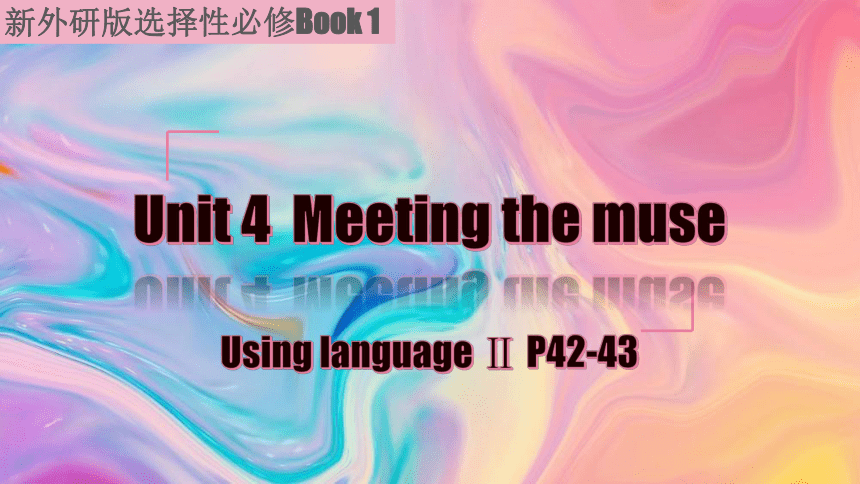 | |
| 格式 | pptx | ||
| 文件大小 | 16.5MB | ||
| 资源类型 | 教案 | ||
| 版本资源 | 外研版(2019) | ||
| 科目 | 英语 | ||
| 更新时间 | 2024-07-21 21:55:35 | ||
图片预览

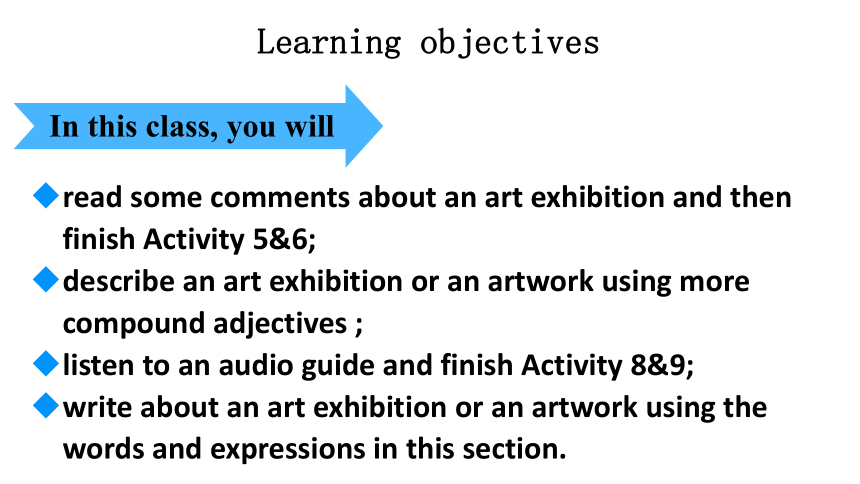
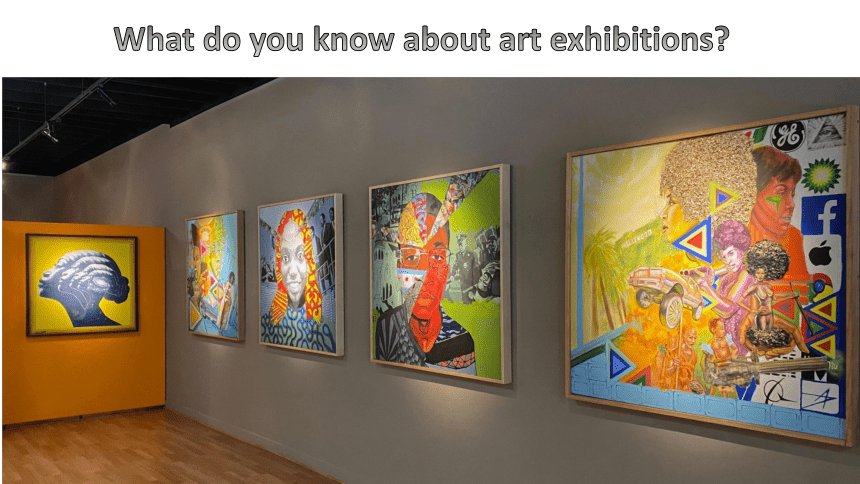

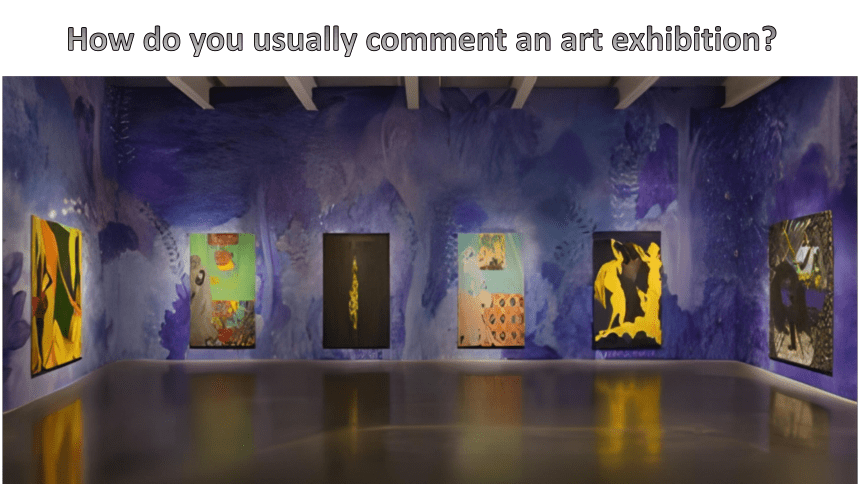

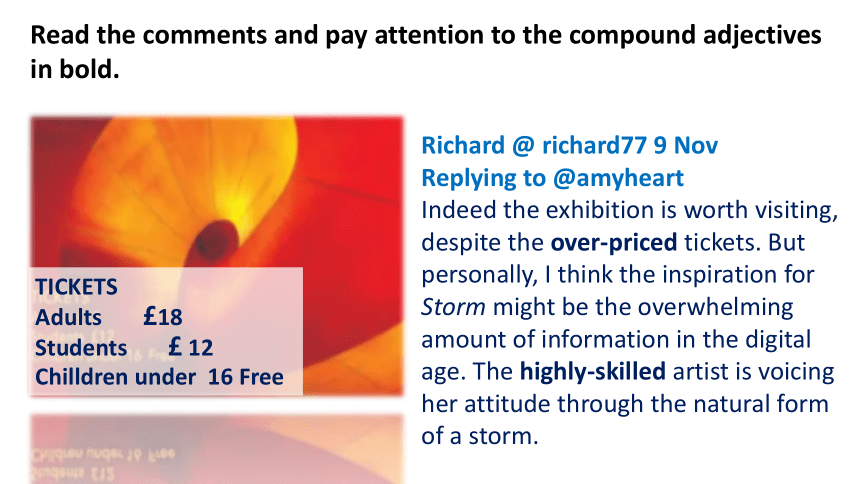
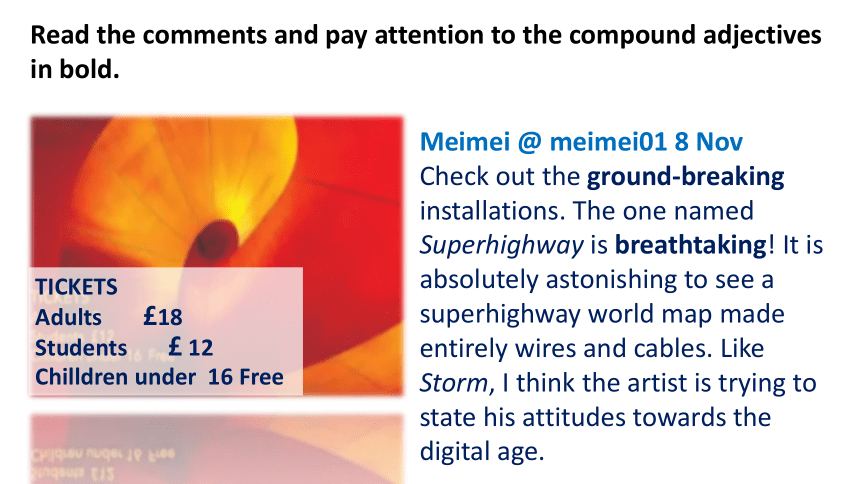
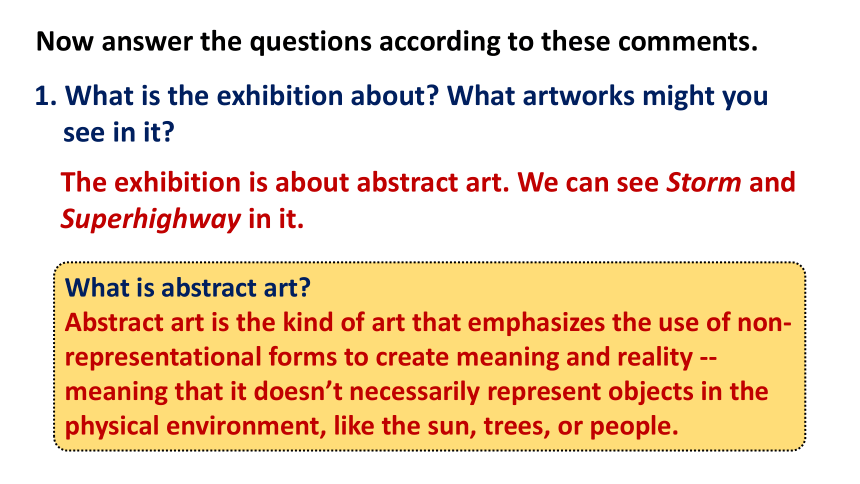
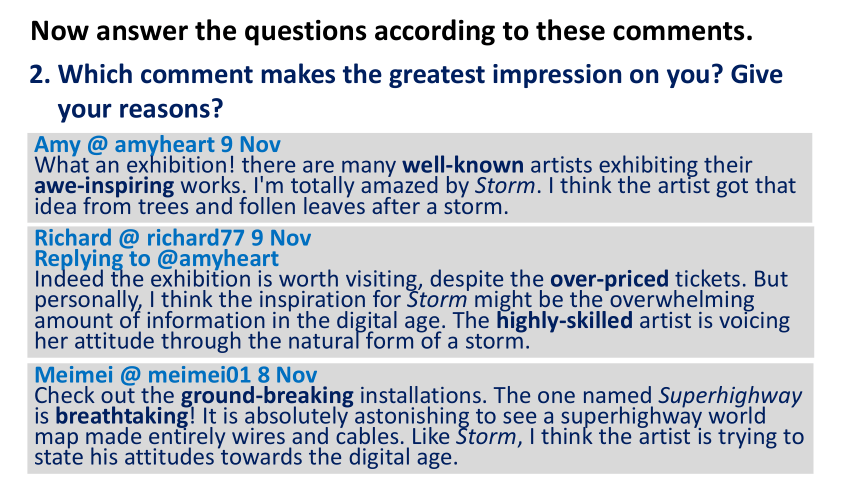
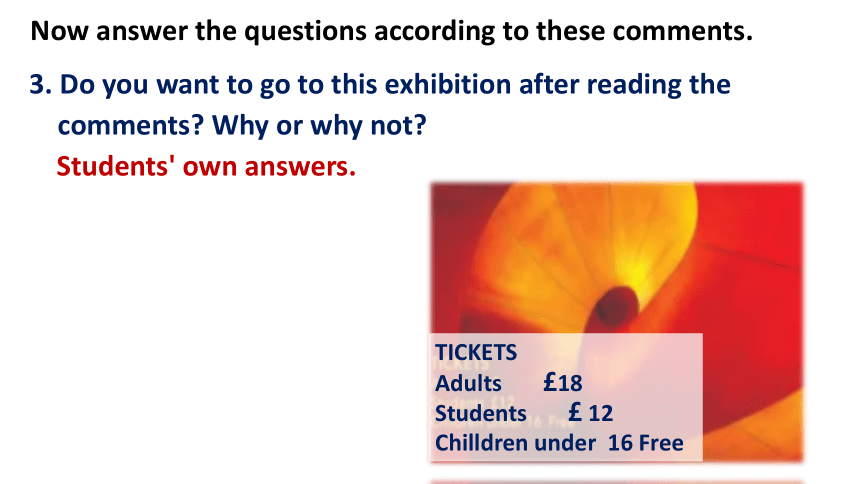

文档简介
(共33张PPT)
新外研版选择性必修Book 1
Unit 4 Meeting the muse
Using language Ⅱ P42-43
Learning objectives
In this class, you will
read some comments about an art exhibition and then finish Activity 5&6;
describe an art exhibition or an artwork using more compound adjectives ;
listen to an audio guide and finish Activity 8&9;
write about an art exhibition or an artwork using the words and expressions in this section.
What do you know about art exhibitions
Have you ever been to an art exhibition
How do you usually comment an art exhibition
TICKETS
Adults 18
Students 12
Chilldren under 16 Free
Amy @ amyheart 9 Nov
What an exhibition! there are many well-known artists exhibiting their awe-inspiring works. I'm totally amazed by Storm. I think the artist got that idea from trees and follen leaves after a storm.
Read the comments and pay attention to the compound adjectives in bold.
Read the comments and pay attention to the compound adjectives in bold.
TICKETS
Adults 18
Students 12
Chilldren under 16 Free
Richard @ richard77 9 Nov
Replying to @amyheart
Indeed the exhibition is worth visiting, despite the over-priced tickets. But personally, I think the inspiration for Storm might be the overwhelming amount of information in the digital age. The highly-skilled artist is voicing her attitude through the natural form of a storm.
TICKETS
Adults 18
Students 12
Chilldren under 16 Free
Meimei @ meimei01 8 Nov
Check out the ground-breaking installations. The one named Superhighway is breathtaking! It is absolutely astonishing to see a superhighway world map made entirely wires and cables. Like Storm, I think the artist is trying to state his attitudes towards the digital age.
Read the comments and pay attention to the compound adjectives in bold.
Now answer the questions according to these comments.
1. What is the exhibition about What artworks might you see in it
The exhibition is about abstract art. We can see Storm and Superhighway in it.
What is abstract art
Abstract art is the kind of art that emphasizes the use of non-representational forms to create meaning and reality --meaning that it doesn’t necessarily represent objects in the physical environment, like the sun, trees, or people.
Now answer the questions according to these comments.
2. Which comment makes the greatest impression on you Give your reasons
Amy @ amyheart 9 Nov
What an exhibition! there are many well-known artists exhibiting their awe-inspiring works. I'm totally amazed by Storm. I think the artist got that idea from trees and follen leaves after a storm.
Richard @ richard77 9 Nov
Replying to @amyheart
Indeed the exhibition is worth visiting, despite the over-priced tickets. But personally, I think the inspiration for Storm might be the overwhelming amount of information in the digital age. The highly-skilled artist is voicing her attitude through the natural form of a storm.
Meimei @ meimei01 8 Nov
Check out the ground-breaking installations. The one named Superhighway is breathtaking! It is absolutely astonishing to see a superhighway world map made entirely wires and cables. Like Storm, I think the artist is trying to state his attitudes towards the digital age.
Now answer the questions according to these comments.
3. Do you want to go to this exhibition after reading the comments Why or why not
Students' own answers.
TICKETS
Adults 18
Students 12
Chilldren under 16 Free
Match the compound adjectives in Activity 5 to their meanings.
well-known
awe-inspiring
over-priced
highly-skilled
breathtaking
ground-breaking
____________: extremely impressive so as to take one's breath away
____________: known by a lot of people
____________: making you feel great respect and admiration, and sometimes fear
____________: very good at doing something
____________: innovative, using methods or achieving new results
____________: very expensive
breathtaking
well-known
awe-inspiring
highly-skilled
ground-breaking
over-priced
Think of other words and expressions that can express the same meanings.
____________: extremely impressive so as to take one's breath away
____________: known by a lot of people
____________: making you feel great respect and admiration, and sometimes fear
____________: very good at doing something
____________: innovative, using methods or achieving new results
____________: very expensive
Work in groups and think of more compound adjectives to describe an art exhibition or an artwork.
In English, you can create compound adjectives by joining two or more words together. You can guess the meaning of compound adjectives by looking at the individual words that make them up. You can even try creating your own compound adjectives!
Learning to learn
What do you know about Pablo Picasso
Pablo Picasso (1881-1973) was one of the most influential artists of the 20th century. Born in Spain, Picasso's artistic talent was evident from a very early age. His works are often categorised into periods, for example the Blue Period and the Rose Period. Among his most famous paintings are the cubist, Les Demoiselles d'Avignon, and Guernica. Picasso's later works often combined elements of his earlier styles.
Pre-listening
What do you know about Feng Zikai
Feng Zika (1898–1975) was an influential painter and cartoonist, and a pioneer of manhua. Born in Tongxiang in the Zhejiang Province, Feng studied at the Zhejiang First Normal School, where he was highly influenced by the famous Japanese-trained teacher Li Shutong. Feng was also an accomplished writer, producing a number of essays on literature, painting, music, and calligraphy, as well as children’s cartoons.
Since the earliest cave paintings, humans have been exhibiting art on walls. There has always been a connection between artists and their works, their points of view, and the viewers. Bringing artworks together into an exhibitior enables all of us to experience the works, to respond to, to enjoy and to connect with them.
Art exhibitions can have many themes, such as a historical period, a location or a trend. Of them all, one ever-lasting source of inspiration is war and peace. Countless artists have been protesting wars and promoting peace via their works, including Spanish artist Pablo Picasso and Chinese artist Feng Zikai, to name just a couple.
Read the passage and get its main idea.
1. What else do you know about Pablo Picasso and Feng Zikai
Students' own answers.
2. What other artists are famous for representing war and peace What are their best-known artworks
Students' own answers.
Now answer the questions according to the passage.
Listen to the audio guide and find out the main message of each artwork.
While-listening
① Guernica
② The Battlefield in Spring
①
②
The title of this painting is Guernica. It was painted by
the well-known Spanish artist, Pablo Picasso. Picasso
painted this huge, breathtaking painting after the attack
on the town of Guernica by the Nazis. It measures about
3.5 metres in height and almost 8 metres in width, and
contains many different elements. In the centre of the painting, we can see a bull, a horse, a light bulb and a dead or wounded man lying on the ground. There have been endless debates about the meaning of these images, but Picasso insisted that it wasn't up to the painter to define them. He said that people must interpret the images as they understand them. Through these images, I can see the tragedy of war, and feel the people's fear as well as Picasso's anger towards the fighting. In the painting, Picasso uses only three colours: black,white and grey. In my opinion, this makes its effect more powerful than using a full range of colours.
①
②
Let's take a look at The Battlefield in Spring by Feng Zikai,
who was one of the pioneers of modern Chinese cartoons.
His illustrations deal with complex social issues in a simple
and lively way, and are widely loved by Chinese people.
This Chinese cartoon is painted in protest of Japanese
aggression against China. In this cartoon, you can see
a small section of a battlefield, made up of sandbags,
an army cap and a wire fence. On one of the sandbags grows some grass leaves. The lifeless objects together with the grass leaves create a strong contrast. Unlike Guernica, I personally think this cartoon delivers quite an optimistic message. It shows that the destruction of war is only temporary, and that the power of life is everlasting. I can feel the strong spirit and hope in this cartoon. It is widely believed that the grass shows Feng Zikai's encouragement to the Chinese people as well as his hope for peace. Through his war cartoons, he wanted to express his belief that Chinese people would win the war and bring peace back to the country.
Listen again and complete the notes.
While-listening
Guernica, by Pablo Picasso
Painted after ____________________ of Guernica
Size: _____________________________
lmages: a bull, a horse, a light bulb and a(n) _______________ lying on the ground
Using only three colours for __________________
The Battle field in spring, by Feng Zikai
Painted __________________ Japanese aggresion against China
Images: sandbags, an army cap, a wire fence and _____________
Contrast achieved with_______________________________
Showing Feng Zikai's _________________________________
Listen again and complete the notes.
While-listening
The title of this painting is Guernica. It was painted by the well-known Spanish artist, Pablo Picasso. Picasso painted this huge, breathtaking painting after the attack on the town of Guernica by the Nazis. It measures about
3.5 metres in height and almost 8 metres in width, and contains many different elements. In the centre of the painting, we can see a bull, a horse, a light bulb and a dead or wounded man lying on the ground. There have been endless debates about the meaning of these images, but Picasso insisted that it wasn't up to the painter to define them. He said that people must interpret the images as they understand them. Through these images, I can see the tragedy of war, and feel the people's fear as well as Picasso's anger towards the fighting. In the painting, Picasso uses only three colours: black,white and grey. In my opinion, this makes its effect more powerful than using a full range of colours.
Listen again and complete the notes.
While-listening
Guernica, by Pablo Picasso
Painted after____________________ of Guernica
Size:____________________________________________
lmages: a bull, a horse, a light bulb and a(n) _____________________ lying on the ground
Using only three colours for_____________________
the attack on the town
3.5 metres in height and almost 8 metres in width
dead or wounded man
a more powerful effect
Let's take a look at The Battlefield in Spring by Feng Zikai, who was one of the pioneers of modern Chinese cartoons. His illustrations deal with complex social issues in a simple and lively way, and are widely loved by Chinese people. This Chinese cartoon is painted in protest of Japanese aggression against China. In this cartoon, you can see a small section of a battlefield, made up of sandbags, an army cap and a wire fence. On one of the sandbags grows some grass leaves. The lifeless objects together with the grass leaves create a strong contrast. Unlike Guernica, I personally think this cartoon delivers quite an optimistic message. It shows that the destruction of war is only temporary, and that the power of life is everlasting. I can feel the strong spirit and hope in this cartoon. It is widely believed that the grass shows Feng Zikai's encouragement to the Chinese people as well as his hope for peace. Through his war cartoons, he wanted to express his belief that Chinese people would win the war and bring peace back to the country.
The Battle field in spring, by Feng Zikai
Painted __________________ Japanese aggresion against China
Images: sandbags, an army cap, a wire fence and _________________
Contrast achieved with_______________________________
Showing Feng Zikai's _________________________________
Listen again and complete the notes.
While-listening
in protest of
some grass leaves
the lifeless objects and the grass leaves
encouragement to the Chinese people as well as his hope for peace
The title of this painting is Guernica. It was painted by the well-known Spanish artist, Pablo Picasso. Picasso painted this huge, breathtaking painting after the attack on the town of Guernica by the Nazis. It measures about 3.5 metres in height and almost 8 metres in width, and contains many different elements. In the centre of the painting, we can see a bull, a horse, a light bulb and a dead or wounded man lying on the ground. There have been endless debates about the meaning of these images, but Picasso insisted that it wasn't up to the painter to define them. He said that people must interpret the images as they understand them. Through these images, I can see the tragedy of war, and feel the people's fear as well as Picasso's anger towards the fighting. In the painting, Picasso uses only three colours: black,white and grey. In my opinion, this makes its effect more powerful than using a full range of colours.
Listening text
Listening text
Let's take a look at The Battlefield in Spring by Feng Zikai, who was one of the pioneers of modern Chinese cartoons. His illustrations deal with complex social issues in a simple and lively way, and are widely loved by Chinese people. This Chinese cartoon is painted in protest of Japanese aggression against China. In this cartoon, you can see a small section of a battlefield, made up of sandbags, an army cap and a wire fence. On one of the sandbags grows some grass leaves. The lifeless objects together with the grass leaves create a strong contrast. Unlike Guernica, I personally think this cartoon delivers quite an optimistic message. It shows that the destruction of war is only temporary, and that the power of life is everlasting. I can feel the strong spirit and hope in this cartoon. It is widely believed that the grass shows Feng Zikai's encouragement to the Chinese people as well as his hope for peace. Through his war cartoons, he wanted to express his belief that Chinese people would win the war and bring peace back to the country.
Post-listening
Complete the table with the expressions from the audio guide.
... by the well-known...
It measures...
In the centre of the painting, we can see...
Through..., I can see / feel...
In my opinion, this makes...
... create a strong contrast.
I personally think...
It is widely believed...
Post-listening
Complete the table with the expressions from the audio guide.
About an artwork Basic information What you see How you feel
... by the well-known...
It measures...
It is widely believed...
In the centre of the painting, we can see...
Through..., I can see...
Through..., I can feel...
In my opinion, this makes...
... create a strong contrast.
I personally think...
Post-listening
Choose an art exhibition, or an artwork from an exhibition you like, and write about it using the words and expressions in this section.
Thank you!
新外研版选择性必修Book 1
Unit 4 Meeting the muse
Using language Ⅱ P42-43
Learning objectives
In this class, you will
read some comments about an art exhibition and then finish Activity 5&6;
describe an art exhibition or an artwork using more compound adjectives ;
listen to an audio guide and finish Activity 8&9;
write about an art exhibition or an artwork using the words and expressions in this section.
What do you know about art exhibitions
Have you ever been to an art exhibition
How do you usually comment an art exhibition
TICKETS
Adults 18
Students 12
Chilldren under 16 Free
Amy @ amyheart 9 Nov
What an exhibition! there are many well-known artists exhibiting their awe-inspiring works. I'm totally amazed by Storm. I think the artist got that idea from trees and follen leaves after a storm.
Read the comments and pay attention to the compound adjectives in bold.
Read the comments and pay attention to the compound adjectives in bold.
TICKETS
Adults 18
Students 12
Chilldren under 16 Free
Richard @ richard77 9 Nov
Replying to @amyheart
Indeed the exhibition is worth visiting, despite the over-priced tickets. But personally, I think the inspiration for Storm might be the overwhelming amount of information in the digital age. The highly-skilled artist is voicing her attitude through the natural form of a storm.
TICKETS
Adults 18
Students 12
Chilldren under 16 Free
Meimei @ meimei01 8 Nov
Check out the ground-breaking installations. The one named Superhighway is breathtaking! It is absolutely astonishing to see a superhighway world map made entirely wires and cables. Like Storm, I think the artist is trying to state his attitudes towards the digital age.
Read the comments and pay attention to the compound adjectives in bold.
Now answer the questions according to these comments.
1. What is the exhibition about What artworks might you see in it
The exhibition is about abstract art. We can see Storm and Superhighway in it.
What is abstract art
Abstract art is the kind of art that emphasizes the use of non-representational forms to create meaning and reality --meaning that it doesn’t necessarily represent objects in the physical environment, like the sun, trees, or people.
Now answer the questions according to these comments.
2. Which comment makes the greatest impression on you Give your reasons
Amy @ amyheart 9 Nov
What an exhibition! there are many well-known artists exhibiting their awe-inspiring works. I'm totally amazed by Storm. I think the artist got that idea from trees and follen leaves after a storm.
Richard @ richard77 9 Nov
Replying to @amyheart
Indeed the exhibition is worth visiting, despite the over-priced tickets. But personally, I think the inspiration for Storm might be the overwhelming amount of information in the digital age. The highly-skilled artist is voicing her attitude through the natural form of a storm.
Meimei @ meimei01 8 Nov
Check out the ground-breaking installations. The one named Superhighway is breathtaking! It is absolutely astonishing to see a superhighway world map made entirely wires and cables. Like Storm, I think the artist is trying to state his attitudes towards the digital age.
Now answer the questions according to these comments.
3. Do you want to go to this exhibition after reading the comments Why or why not
Students' own answers.
TICKETS
Adults 18
Students 12
Chilldren under 16 Free
Match the compound adjectives in Activity 5 to their meanings.
well-known
awe-inspiring
over-priced
highly-skilled
breathtaking
ground-breaking
____________: extremely impressive so as to take one's breath away
____________: known by a lot of people
____________: making you feel great respect and admiration, and sometimes fear
____________: very good at doing something
____________: innovative, using methods or achieving new results
____________: very expensive
breathtaking
well-known
awe-inspiring
highly-skilled
ground-breaking
over-priced
Think of other words and expressions that can express the same meanings.
____________: extremely impressive so as to take one's breath away
____________: known by a lot of people
____________: making you feel great respect and admiration, and sometimes fear
____________: very good at doing something
____________: innovative, using methods or achieving new results
____________: very expensive
Work in groups and think of more compound adjectives to describe an art exhibition or an artwork.
In English, you can create compound adjectives by joining two or more words together. You can guess the meaning of compound adjectives by looking at the individual words that make them up. You can even try creating your own compound adjectives!
Learning to learn
What do you know about Pablo Picasso
Pablo Picasso (1881-1973) was one of the most influential artists of the 20th century. Born in Spain, Picasso's artistic talent was evident from a very early age. His works are often categorised into periods, for example the Blue Period and the Rose Period. Among his most famous paintings are the cubist, Les Demoiselles d'Avignon, and Guernica. Picasso's later works often combined elements of his earlier styles.
Pre-listening
What do you know about Feng Zikai
Feng Zika (1898–1975) was an influential painter and cartoonist, and a pioneer of manhua. Born in Tongxiang in the Zhejiang Province, Feng studied at the Zhejiang First Normal School, where he was highly influenced by the famous Japanese-trained teacher Li Shutong. Feng was also an accomplished writer, producing a number of essays on literature, painting, music, and calligraphy, as well as children’s cartoons.
Since the earliest cave paintings, humans have been exhibiting art on walls. There has always been a connection between artists and their works, their points of view, and the viewers. Bringing artworks together into an exhibitior enables all of us to experience the works, to respond to, to enjoy and to connect with them.
Art exhibitions can have many themes, such as a historical period, a location or a trend. Of them all, one ever-lasting source of inspiration is war and peace. Countless artists have been protesting wars and promoting peace via their works, including Spanish artist Pablo Picasso and Chinese artist Feng Zikai, to name just a couple.
Read the passage and get its main idea.
1. What else do you know about Pablo Picasso and Feng Zikai
Students' own answers.
2. What other artists are famous for representing war and peace What are their best-known artworks
Students' own answers.
Now answer the questions according to the passage.
Listen to the audio guide and find out the main message of each artwork.
While-listening
① Guernica
② The Battlefield in Spring
①
②
The title of this painting is Guernica. It was painted by
the well-known Spanish artist, Pablo Picasso. Picasso
painted this huge, breathtaking painting after the attack
on the town of Guernica by the Nazis. It measures about
3.5 metres in height and almost 8 metres in width, and
contains many different elements. In the centre of the painting, we can see a bull, a horse, a light bulb and a dead or wounded man lying on the ground. There have been endless debates about the meaning of these images, but Picasso insisted that it wasn't up to the painter to define them. He said that people must interpret the images as they understand them. Through these images, I can see the tragedy of war, and feel the people's fear as well as Picasso's anger towards the fighting. In the painting, Picasso uses only three colours: black,white and grey. In my opinion, this makes its effect more powerful than using a full range of colours.
①
②
Let's take a look at The Battlefield in Spring by Feng Zikai,
who was one of the pioneers of modern Chinese cartoons.
His illustrations deal with complex social issues in a simple
and lively way, and are widely loved by Chinese people.
This Chinese cartoon is painted in protest of Japanese
aggression against China. In this cartoon, you can see
a small section of a battlefield, made up of sandbags,
an army cap and a wire fence. On one of the sandbags grows some grass leaves. The lifeless objects together with the grass leaves create a strong contrast. Unlike Guernica, I personally think this cartoon delivers quite an optimistic message. It shows that the destruction of war is only temporary, and that the power of life is everlasting. I can feel the strong spirit and hope in this cartoon. It is widely believed that the grass shows Feng Zikai's encouragement to the Chinese people as well as his hope for peace. Through his war cartoons, he wanted to express his belief that Chinese people would win the war and bring peace back to the country.
Listen again and complete the notes.
While-listening
Guernica, by Pablo Picasso
Painted after ____________________ of Guernica
Size: _____________________________
lmages: a bull, a horse, a light bulb and a(n) _______________ lying on the ground
Using only three colours for __________________
The Battle field in spring, by Feng Zikai
Painted __________________ Japanese aggresion against China
Images: sandbags, an army cap, a wire fence and _____________
Contrast achieved with_______________________________
Showing Feng Zikai's _________________________________
Listen again and complete the notes.
While-listening
The title of this painting is Guernica. It was painted by the well-known Spanish artist, Pablo Picasso. Picasso painted this huge, breathtaking painting after the attack on the town of Guernica by the Nazis. It measures about
3.5 metres in height and almost 8 metres in width, and contains many different elements. In the centre of the painting, we can see a bull, a horse, a light bulb and a dead or wounded man lying on the ground. There have been endless debates about the meaning of these images, but Picasso insisted that it wasn't up to the painter to define them. He said that people must interpret the images as they understand them. Through these images, I can see the tragedy of war, and feel the people's fear as well as Picasso's anger towards the fighting. In the painting, Picasso uses only three colours: black,white and grey. In my opinion, this makes its effect more powerful than using a full range of colours.
Listen again and complete the notes.
While-listening
Guernica, by Pablo Picasso
Painted after____________________ of Guernica
Size:____________________________________________
lmages: a bull, a horse, a light bulb and a(n) _____________________ lying on the ground
Using only three colours for_____________________
the attack on the town
3.5 metres in height and almost 8 metres in width
dead or wounded man
a more powerful effect
Let's take a look at The Battlefield in Spring by Feng Zikai, who was one of the pioneers of modern Chinese cartoons. His illustrations deal with complex social issues in a simple and lively way, and are widely loved by Chinese people. This Chinese cartoon is painted in protest of Japanese aggression against China. In this cartoon, you can see a small section of a battlefield, made up of sandbags, an army cap and a wire fence. On one of the sandbags grows some grass leaves. The lifeless objects together with the grass leaves create a strong contrast. Unlike Guernica, I personally think this cartoon delivers quite an optimistic message. It shows that the destruction of war is only temporary, and that the power of life is everlasting. I can feel the strong spirit and hope in this cartoon. It is widely believed that the grass shows Feng Zikai's encouragement to the Chinese people as well as his hope for peace. Through his war cartoons, he wanted to express his belief that Chinese people would win the war and bring peace back to the country.
The Battle field in spring, by Feng Zikai
Painted __________________ Japanese aggresion against China
Images: sandbags, an army cap, a wire fence and _________________
Contrast achieved with_______________________________
Showing Feng Zikai's _________________________________
Listen again and complete the notes.
While-listening
in protest of
some grass leaves
the lifeless objects and the grass leaves
encouragement to the Chinese people as well as his hope for peace
The title of this painting is Guernica. It was painted by the well-known Spanish artist, Pablo Picasso. Picasso painted this huge, breathtaking painting after the attack on the town of Guernica by the Nazis. It measures about 3.5 metres in height and almost 8 metres in width, and contains many different elements. In the centre of the painting, we can see a bull, a horse, a light bulb and a dead or wounded man lying on the ground. There have been endless debates about the meaning of these images, but Picasso insisted that it wasn't up to the painter to define them. He said that people must interpret the images as they understand them. Through these images, I can see the tragedy of war, and feel the people's fear as well as Picasso's anger towards the fighting. In the painting, Picasso uses only three colours: black,white and grey. In my opinion, this makes its effect more powerful than using a full range of colours.
Listening text
Listening text
Let's take a look at The Battlefield in Spring by Feng Zikai, who was one of the pioneers of modern Chinese cartoons. His illustrations deal with complex social issues in a simple and lively way, and are widely loved by Chinese people. This Chinese cartoon is painted in protest of Japanese aggression against China. In this cartoon, you can see a small section of a battlefield, made up of sandbags, an army cap and a wire fence. On one of the sandbags grows some grass leaves. The lifeless objects together with the grass leaves create a strong contrast. Unlike Guernica, I personally think this cartoon delivers quite an optimistic message. It shows that the destruction of war is only temporary, and that the power of life is everlasting. I can feel the strong spirit and hope in this cartoon. It is widely believed that the grass shows Feng Zikai's encouragement to the Chinese people as well as his hope for peace. Through his war cartoons, he wanted to express his belief that Chinese people would win the war and bring peace back to the country.
Post-listening
Complete the table with the expressions from the audio guide.
... by the well-known...
It measures...
In the centre of the painting, we can see...
Through..., I can see / feel...
In my opinion, this makes...
... create a strong contrast.
I personally think...
It is widely believed...
Post-listening
Complete the table with the expressions from the audio guide.
About an artwork Basic information What you see How you feel
... by the well-known...
It measures...
It is widely believed...
In the centre of the painting, we can see...
Through..., I can see...
Through..., I can feel...
In my opinion, this makes...
... create a strong contrast.
I personally think...
Post-listening
Choose an art exhibition, or an artwork from an exhibition you like, and write about it using the words and expressions in this section.
Thank you!
